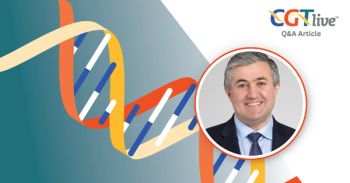
The Importance of Precise Reproducibility of AAVs
Scott Jeffers, PhD, the chief technology officer at GenSight Biologics, discussed using Verdot’s FlexiPro system to produce Lumevoq gene therapy.
Manufacturing of adeno-associated virus (AAV) vector-based gene therapy products is a complex and expensive process with many steps. Notably, GenSight Biologics has recently shifted to using
The 2 companies presented on the benefits attained from the shift at
CGTLive: Can you tell us a bit about GenSight Biologics?
Scott Jeffers, PhD: The disease that we're specifically looking at is Leber's hereditary optic neuropathy (LHON); it's a blinding disease that affects mainly men between the age of 15 and 35 and causes them to go completely blind within about 12 months. The gene therapy we're using is an AAV vector. So AAV gene therapy uses a really small virus that is directly injected into the eye, and goes to the retina and changes the retina with a gene that treats the issue.
We have a specific step within our process which is used to purify the viral vector and we use a machine from Verdot that runs this for us. Why is this important? Well, because the purity of the viral vector is super important. It needs to be ultra pure and ready to go to be injected into people, in order to be safe and effective and potent, and to make sure that it's doing what it's supposed to do. But the purification process needs to also be controlled really well. We need it to be reproducible. We need to do it over and over again. It needs to do the same thing every time we do it. We need to know that it's doing it in the same way, as well as be able to monitor that and know that it is doing it in the same way.
So we've used other machines in the past, and those machines have not been trusted by operators or have not done what we've expected them to do. [On the other hand,] Verdot's machine, the FlexiPro, has allowed the team to not only trust the instrument, but also reproducibly use this instrument to manufacture our product. We've recently converted over to this system and it has been working to a great extent to increase trust, increase reproducibility, and to give us product that is as expected, and that's where we are. Verdot has been instrumental in making sure that their system is working well in our process and they've supplied technicians to help and technicians to train and really have done everything that they can to make sure that we're able to manufacture our product.
What did GenSight and Verdot present at ASGCT?
The key points of the poster presentation were that we had a system that we were using that was not fit for purpose and it was not working the way that we needed it to work to reproducibly manufacture our product. When we switched over to Verdot, it was trusted by operators. It really did what it said it was going to do, and we could use all of the sensors, which we weren't previously doing in our older system. This showed the reproducibility increased, and allowed us to quickly move through our steps and purification process.
What is the FlexiPro Chrom system?
The FlexiPro Chrom system is the system that we are using to do this purification. Basically what it is a set of pumps, a set of tubing, a set of sensors, and a set of valves that control how the product flows through the system. It goes on to a column where the AAV is captured and then is knocked off the column by changing a buffer within the system and then collected in a bag outside of the system to be further processed... That's exactly what it is. It's a set of pumps and a set of sensors and a set of tubes.
What would you say is the big picture takeaway of what you've discussed here?
I would like to say the things that have been going on with with Verdot have been great. They've been a great collaborator, they've worked with us very well to ensure that we can produce our product and get it to the patients as quickly as possible. They've been very helpful in getting consumables to us and really making sure that we can produce our material as quickly as possible.
This transcript has been edited for clarity.
REFERENCES
1. GenSight Biologics confirms sustained efficacy and safety of bilateral LUMEVOQ® injections four years after one-time administration. News release. GenSight Biologics. March 20, 2024. https://www.gensight-biologics.com/2024/03/20/gensight-biologics-confirms-sustained-efficacy-and-safety-of-bilateral-lumevoq-injections-four-years-after-one-time-administration/
2. Increased Reproducibility in a Critical Downstream Processing Step Allows for Speed to Commercialization of Gene Therapy Product to Treat Leber's Hereditary Optic Neuropathy (LHON). Presented at: Presented at: ASGCT 27th Annual Meeting, May 7-10; Baltimore, Maryland. Abstract #1031
Newsletter
Stay at the forefront of cutting-edge science with CGT—your direct line to expert insights, breakthrough data, and real-time coverage of the latest advancements in cell and gene therapy.
















































